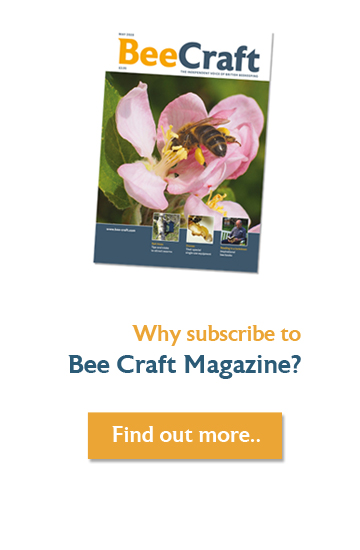Free Bees?
By Margaret Cowley, MSc
What is a bait hive?
A bait hive is an empty hive which is deliberately set up to attract a swarm.
 You are providing a home for a swarm which would otherwise have to take its chances in a hollow tree, or chimney, or similar.
You are providing a home for a swarm which would otherwise have to take its chances in a hollow tree, or chimney, or similar.
The bees are far more likely to survive with you to look after them. You can check for diseases and treat as necessary, whereas a feral colony would harbour the disease and might also become a nuisance.
Will I be inviting trouble in the form of disease?
If the swarm is from another apiary or from a feral colony, it may carry diseases. It is essential to assume that this is the case until you have been able to examine its brood and satisfy yourself that the colony is disease-free. Until then, do not exchange frames and/or bees with any from your other colonies and always wash your hive tool and gloves with washing soda solution after examining the bait hive colony.
Using mainly frames of foundation rather than drawn comb in the bait hive will ensure that the nectar or honey that the swarm bees carry with them will be digested, assimilated and converted to wax and energy. This reduces the likelihood of depositing disease spores in their new home or of infecting new brood by giving them contaminated food.
What will I need to create a bait hive?
You can use an old hive body with its floor, crownboard and roof. An entrance block with a narrow opening will keep mice out.
Place at least one frame of drawn comb in the middle. The smell of used comb helps attract a swarm and the queen can start to lay immediately if she is already mated. Swarms are keen to build comb, so make up the box contents with frames of foundation.
Place the hive at least one metre off the ground as bees naturally seek new homes high up in trees. If the aim is to catch your own escapees, site your bait hive at least 200 metres away from your apiary. This is because scout bees select nest sites some distance away from the parent hive. If you haven’t enough room, bait hives set up in your own apiary may well collect swarms from other beekeepers’ colonies.
When should I set it up?
 Wax moth adults will be attracted to unprotected comb and lay their eggs on it. These will hatch into larvae which will destroy the comb. To avoid this, set up the hive only in the swarming season, ie, mid-April to early June, and inspect the combs every so often.
Wax moth adults will be attracted to unprotected comb and lay their eggs on it. These will hatch into larvae which will destroy the comb. To avoid this, set up the hive only in the swarming season, ie, mid-April to early June, and inspect the combs every so often.
If you had left frames in a freezer for two days in the previous autumn, that will have killed any moth eggs. Do not be tempted to use frames with honey in them; this will only attract ants.
Is there anything I can do to increase my chances of attracting a swarm?
You can buy swarm lures to put in the bait hive (about £6 for two phials). They contain a blend of synthetic pheromones identical to those present in the worker’s scent gland. The active ingredient diffuses through the plastic container so a lure will only last one season but could be used to attract several swarms in succession.
Swarm lures are particularly useful if you have no drawn comb. Old hives are more attractive than brand new ones. There is evidence that propolis plays a part. Try boiling some propolis-covered comb or old frames in water and smearing the liquid on the inside of the bait hive.
What do I do with the bees once I notice the bait hive is occupied?
If you notice scout bees hovering near the entrance, visit the bait hive daily as a swarm might occupy it any time. Frantic activity and bees returning with pollen loads will signal that you have been successful. Examine the colony in the usual way. Is the queen marked? If so, she is probably at least one year old. If not, has she already started to lay eggs, or is she a virgin? In the latter case, leave the colony alone for three weeks so that she can go on her mating flights undisturbed.
You can take advantage of the swarm’s urge to build comb by feeding plenty of 1:1 (thin) syrup which the workers will convert to wax immediately. However, delay feeding for three days after the swarm’s arrival to ensure that all possibly infected nectar or honey that they might have brought with them is used up. Any foundation will soon be drawn out and used for brood rearing.
 Make sure the larvae are free of disease (consult the Bee Craft apiary guides for a pictorial reference). If you have any doubts, call a bee inspector. Check for varroa by placing a mesh-covered tray on the floor for a few days and examining the debris. Treat if necessary.
Make sure the larvae are free of disease (consult the Bee Craft apiary guides for a pictorial reference). If you have any doubts, call a bee inspector. Check for varroa by placing a mesh-covered tray on the floor for a few days and examining the debris. Treat if necessary.
You could move the hive to your own apiary by moving it around 1 m (3 ft) each day. A milk crate makes a handy temporary hive stand. If the colony is bad tempered or displays any other undesirable characteristics, you should find and remove the queen and unite the swarm with another colony using the newspaper method. Otherwise, when the bees have stopped flying, move the colony to another apiary over three miles away.




